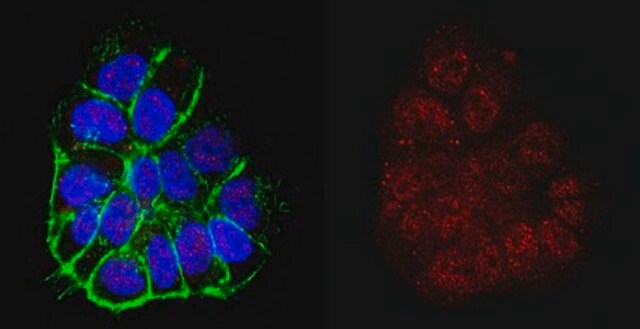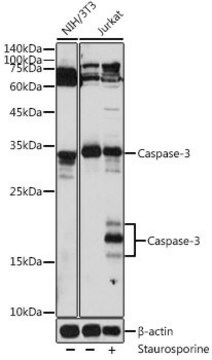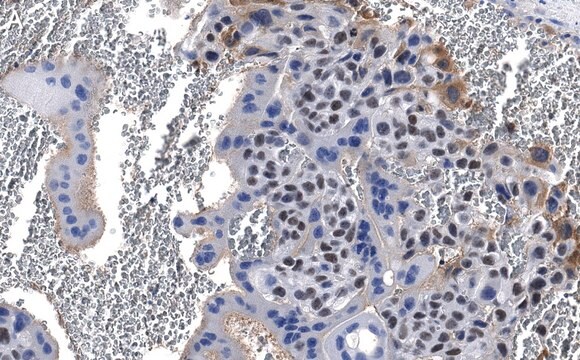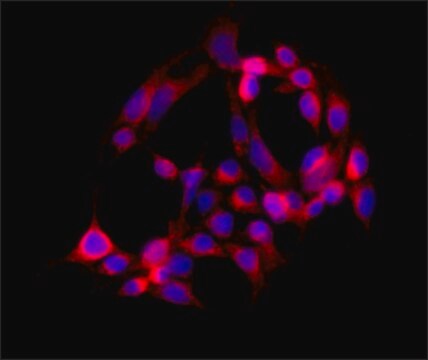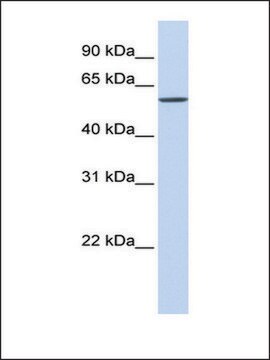推薦產品
生物源
mouse
品質等級
抗體表格
purified immunoglobulin
抗體產品種類
primary antibodies
無性繁殖
7D5.2, monoclonal
物種活性
human
技術
immunohistochemistry: suitable (paraffin)
western blot: suitable
同型
IgG2aκ
NCBI登錄號
UniProt登錄號
運輸包裝
ambient
目標翻譯後修改
unmodified
基因資訊
human ... TERT(7015)
一般說明
Telomerase reverse transcriptase (EC 2.7.7.49; UniProt O14746; also known as hEST2, hTRT, Telomerase-associated protein 2, Telomerase catalytic subunit, TP2) is encoded by the TERT (also known as CMM9, DKCA2, DKCB4, EST2, PFBMFT1, TCS1, TRT) gene (Gene ID 7015) in human. Telomerase reverse transcriptase (TERT) is the catalytic subunit of the telomerase responsible for adding TTAGGG repeats to the chromosome telomere ends. Cells with low or no telomerase expression lose telomere repeats during cell division, eventually resulting in cellular senescence. Most cancer cells, germ cells and embryonic stem cells express high levels of telomerase, thus contributing to pluripotency and immortality. In addition to its telomere maintenance function, telomerase also has a pro-survival role in cellular resistance against DNA damage and ensuing apoptosis. Most cancer cells are highly proliferative and express high levels of nuclear telomerase activity. Studies show that TERT shuttles from the nucleus into mitochondria upon oxidative stress induction in cancer cells. TERT mitochondrial localization helps prevent nuclear DNA damage by decreasing mitochondrial reactive oxygen species (ROS), accounting for high stress resistance especially among the cancer stem cells (CSCs) population. Following exposure to H2O2 or gamma-irradiation, cancer cells capable of excluding TERT from the nucleus display little or no DNA damage, while TERT nuclear retainment results in high DNA damage.
特異性
Clone 7D5.2 targets a sequence toward the end of the C-terminal extension (CTE) region present in spliced isoforms 1 and 3, but not in isoforms 2 and 4 of human TERT reported by UniProt (O14746).
免疫原
KLH-conjugated linear peptide corresponding to a sequence toward the end of the C-terminal extension (CTE) region of human TERT.
應用
Anti-TERT, clone 7D5.2 , Cat. No. MABE662, is a highly specific mouse monoclonal antibody that targets hTERT and has been tested in Immunohistochemistry (Paraffin) and Western Blotting.
Immunohistochemistry Analysis: A 1:50 dilution from a representative lot detected TERT in human cerebral cortex, kidney, and tonsil tissue sections.
Western Blotting Analysis: 1 µg/mL from a representative lot detected TERT in 10 µg of Jurkat cell lysate.
Western Blotting Analysis: 1 µg/mL from a representative lot detected TERT in 10 µg of Jurkat cell lysate.
品質
Evaluated by Western Blotting in PC3 cell lysate.
Western Blotting Analysis: 1 µg/mL of this antibody detected TERT in 10 µg of PC3 human prostate cancer cell lysate.
Western Blotting Analysis: 1 µg/mL of this antibody detected TERT in 10 µg of PC3 human prostate cancer cell lysate.
標靶描述
~140 kDa observed. 127.0/120.0 kDa (human isoform 1/3) calculated. Uncharacterized bands may be observed in some lysate(s).
聯結
Replaces: MABE14
外觀
Format: Purified
Purified mouse IgG2a in buffer containing 0.1 M Tris-Glycine (pH 7.4), 150 mM NaCl with 0.05% sodium azide
其他說明
Concentration: Please refer to lot specific datasheet.
未找到適合的產品?
試用我們的產品選擇工具.
儲存類別代碼
12 - Non Combustible Liquids
水污染物質分類(WGK)
WGK 1
閃點(°F)
Not applicable
閃點(°C)
Not applicable
分析證明 (COA)
輸入產品批次/批號來搜索 分析證明 (COA)。在產品’s標籤上找到批次和批號,寫有 ‘Lot’或‘Batch’.。
我們的科學家團隊在所有研究領域都有豐富的經驗,包括生命科學、材料科學、化學合成、色譜、分析等.
聯絡技術服務
